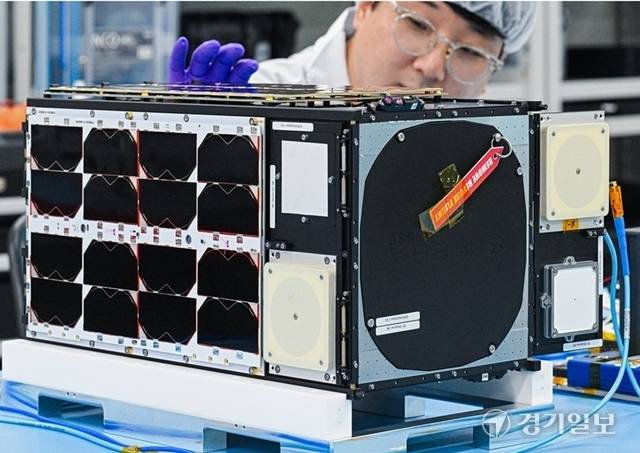Other news

What is Antenna Gain in Satellite Communications? (Explained simply)
Read more
Reflectarray Antennas for Small Satellites: From Concept to First Commercial Deployment
Read more
In today’s tech world, satellite navigation is crucial, driving research, communication, and daily innovations. At the heart of this navigation revolution is the Global Navigation Satellite System (GNSS) – a synergy of satellites that offers autonomous geo-spatial positioning and timing. As we increasingly rely on Low Earth Orbit (LEO) satellites for a myriad of applications, from earth observation to broadband data transmission, the demand for their precise and reliable positioning has never been higher.
However, as GNSS has evolved, so too has the complexity of the systems and the frequencies they operate on. Gone are the days when one could rely on a single GNSS constellation or a singular frequency band. With the proliferation of GNSS systems, each operating on its independent infrastructure and signals, emerges a pressing question: Why is it essential for navigation antennas, which serve to navigate these LEO satellites, to cover all GNSS bands and all constellations?
In this article, we’ll dive into GNSS, exploring its history, technical nuances, the importance of frequency bands, and the crucial need for comprehensive band coverage in satellite navigation.

The genesis of GNSS can be traced back to the inception of the Global Positioning System (GPS) by the United States in the 1970s. Initially designed for military navigation, GPS’s success soon catalyzed the development of similar systems worldwide. Following in its footsteps, Russia launched GLONASS, Europe developed Galileo, and China contributed with BeiDou. Alongside these global systems, regional navigation satellite systems also emerged, such as the Indian Regional Navigation Satellite System (IRNSS) and the European Geostationary Navigation Overlay Service (EGNOS). As these global and regional navigation satellite systems flourished, they transitioned from being mere strategic assets to integral components of our global technological infrastructure, enhancing the overall capability and reach of satellite-based navigation services.
The beauty of GNSS lies in its ability to offer real-time, accurate positioning almost anywhere on Earth. By leveraging the science of trilateration and the strategic positioning of satellites in MEO, GNSS has revolutionized navigation and positioning systems as we know them.
Space is vast, and the margin for error is minuscule. As we deploy satellites, particularly those in Low Earth Orbit (LEO), precision in their position is paramount. Accurate positioning ensures that satellites function as intended, be it for communication, imaging, or other specific missions. A slight deviation in their trajectory or position can lead to compromised data or, worse, collisions with other space objects.
Traditional ground-based tracking systems, while efficient, have limitations when it comes to offering real-time onboard data. GNSS equips satellites with the capability to know their position in real-time. This instantaneous knowledge allows for quick adjustments, if necessary, ensuring optimal performance and reducing risks associated with orbital congestion.
As we progress into an era where satellite constellations and formation flying become more prevalent, the need for precise relative positioning grows exponentially. GNSS allows satellites to maintain specific formations, which is vital for tasks like synchronized observations or communication relay chains with distributed instruments and payloads.
While ground stations offer essential support, relying solely on them can be restrictive. GNSS provides satellites with a level of autonomy, allowing them to operate efficiently without continuous check-ins with ground-based systems. This independence is particularly beneficial for satellites that might be out of the line of sight from ground stations for extended periods. This technology will probably be a key in future space collision avoidance systems that will emerge in the future.
In essence, GNSS serves as the backbone for modern satellite operations, ensuring they remain precise, efficient, and autonomous in their functions.
The Global Navigation Satellite Systems (GNSS) employ a variety of frequency bands to broadcast navigation signals, ensuring precision and reliability. These bands cater to a broad range of applications, each with its distinct attributes and advantages. Here’s an in-depth look:
Given the vast number of signals transmitted in the radio spectrum, it’s crucial to prevent interference between different services. This is especially important for GNSS bands, which are strategically selected to avoid conflicts, ensuring that navigation signals remain clear and uninterrupted. The International Telecommunication Union (ITU), along with other international bodies and agreements, plays a pivotal role in this context. The ITU works meticulously to allocate and protect these spectral regions, ensuring fair and efficient use of the radio spectrum. Such coordinated efforts are vital in safeguarding the integrity and reliability of GNSS operations globally.
The simultaneous use of multiple frequency bands paves the way for advanced GNSS techniques:
Lastly, redundancy is pivotal for any mission-critical system. If one band encounters a problem, be it technical glitches, interference, or deliberate jamming, GNSS can still rely on other available bands and global navigation systems to maintain service integrity.
However, it is crucial to understand that the full suite of benefits provided by these diverse GNSS frequency bands can only be harnessed with the use of a dedicated receiver, designed to be capable of processing multiple frequencies from multiple constellations simultaneously. Such receivers are inherently complex pieces of technology. Their sophistication is directly proportional to the number of frequencies they can manage, especially as they are tasked with decoding the signals transmitted across these bands to offer precise positioning and timing information.
As the technology has advanced, the emergence of full digital receivers is progressively addressing the challenge of complexity versus capability. These state-of-the-art devices are not only equipped to handle the standard L1 and L2 bands, but they are also adept at managing the additional signals like the L5 and the Galileo’s E6 band. The E6 band, operating at around 1260 MHz, in particular, requires receivers to have a higher level of intricacy due to its advanced features aimed at providing the High Accuracy Service.
As the world of GNSS continuously evolves, it’s crucial to stay ahead of the curve, anticipating advancements and adapting swiftly. One such progression is the increased focus on the E6 frequency band. But what makes the E6 band so significant, and how is it reshaping the future of GNSS?
The E6 band is not just another frequency; it is a signal that provides advanced navigation services, including commercial and safety-critical applications that necessitate high-fidelity processing. Therefore, the receiver’s design and its ability to cope with this complexity is crucial. It must be equipped with sophisticated hardware and software algorithms capable of discriminating between the different frequencies, correcting for potential errors, and utilizing the specific advantages that each frequency band and modulation offers.
As satellite technology evolves, there’s a significant shift towards Software-Defined Radio (SDR) architecture. This transition marks a departure from traditional designs, allowing satellites to employ various sensors, including advanced antennas, in a more integrated and flexible manner. Modern GNSS receivers are embracing this Software-Defined Architecture (SDA), where a complete sensor – including the antenna, filters and low noise amplifiers – is provided as an integrated unit. This approach, championed by Anywaves, significantly streamlines the satellite design process.
One of the notable advantages of this evolution is the elimination of the need to source and assemble different components separately. This integration not only simplifies the procurement and compatibility challenges but also enhances overall system performance. By offering a complete sensor ready to be connected, Anywaves is making satellite assembly more efficient and reliable.
Eliminating the cable in this integrated setup brings another benefit: an increase in the sensitivity of the RF sensor. This improvement is a direct result of reducing signal losses typically associated with cable connections. Furthermore, for customers, this design offers unprecedented flexibility. They can select the cable length according to their specific needs and have the freedom to position the antenna more strategically on their platform. This flexibility ensures hassle-free installation and zero impact on performance, allowing for optimal antenna placement without the traditional constraints.
Satellite navigation, underpinned by the intricate workings of the Global Navigation Satellite System (GNSS), has emerged as a cornerstone of modern technological advancements. The rapidly evolving landscape of GNSS accentuates the essential role of frequency bands in ensuring optimal navigation, with an ever-growing emphasis on comprehensive band coverage.
While the journey of GNSS has been marked by incredible progress, challenges, both old and new, continue to emerge. These hurdles only emphasize the need for innovative solutions, and companies like Anywaves are at the forefront, pushing the boundaries of what’s possible. From pioneering the integration of the promising E6 band to exploring advanced signal quality enhancements, Anywaves is charting a visionary path.
As we look towards the future, the integration and utilization of all GNSS bands will be pivotal in ensuring precision, reliability, and resilience in satellite navigation. Don’t hesitate to contact our team to talk about your GNSS antenna needs!
Discover our GNSS All-Bands Antenna



If you have any question, we would be happy to help you out.